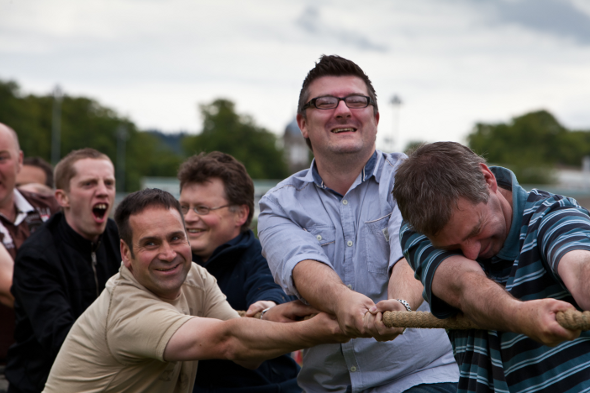 Anthony Schrag. A Perfect Father Day? Tug of War. 2011. Deveron Arts. Photo: Jan Holm.
Anthony Schrag. A Perfect Father Day? Tug of War. 2011. Deveron Arts. Photo: Jan Holm.
Territories and Practices in Process
Jessica Gogan e Luiz Guilherme Vergara
In the last few decades we have seen various turns in contemporary art, so-called by European and American critics. Whether ethnographic, social or educational, these turns point to desires to escape market values, to seek new forms of criticality and to convergences between artistic, curatorial and pedagogic practices.
But perhaps it is less a question of a specific turn, which might imply a certainty in relation to its direction, and more an indication of the state of turning–a continuous questioning–that subverts the roles and values of the traditional territories and practices of art’s production and reception. Here, Uruguayan artist Torres Garcia’s famous South America’s Inverted Map, 1936, showing the south as now north, could be deployed as the poetic posterchild of this new cartography of reversibility and simultaneity. Dichotomies, hierarchies and traditional frontiers between center/periphery, north/south, and creator/spectator are being turned, collapsed, and, at times, re-turned. These shifts not only suggest the opening up of art making processes to collectivity, collaboration and new territorialities, but also point to the activation and subversion of the very places and situations of art’s reception as new frontiers for creative and critical production.
In these critical and creative scenarios, cities and public spaces emerge as vital fields of invention and political, esthetic and ethical negotiation. Whether urban or rural, cities, their streets, peripheries, public squares, and markets become contexts for social and political issues as well as a poetics of everyday inventions. In this way, more than an “expanded” field for an artist’s work, the city is a vital territory of polyphony. Art and education wade in, searching for criticality, new practices, forms and formats, and a more palpable sense of publicness provoking rich questions around issues of context, place, time, and art’s symbolic resonance. The work of art, as Dewey would say, pulsates in these contexts and situations, juxtaposing sensitive (in)coherences of both agency and rupture, creating and challenging territories of processes. It is to this creative and critical zone that we direct a series of multifocal lenses, where artistic, curatorial and pedagogic practices are continually re-constructed in relation to their potential for action and transformation and possibility to re-imagine institutions and interfaces, forms and formats of social interaction.
Dissemination and Dispersion
MESA magazine, the biannual digital publication of Instituto MESA, proposes to explore these connections between art and society in their ethical and aesthetic complexity and density. In this inaugural issue we bring together national and international case studies, articles, photographic essays, and interviews to draw attention to some of the singularities and resonant practices of contemporary art’s situations and contexts through new critical lenses. Within these territories, specific practices emerge as key, such as listening, observation, witnessing and collecting as well as those emphasizing proximity, care, and complicity. Here Tania Rivera, invited critic and researcher for this issue, observes that the potential for poetic contamination and transformative resonance of art on the subject (and the world) depend on the dissemination and dispersion of its meanings and emergent concepts. We hope that MESA magazine can play a role as a territory for critical, creative and dispersive practice.
Proximity, Complicity, Care, and Witnessing
Territories are defined by their practices; in turn practices are embodied in their territorializations–moments of instantiation amidst the daily flux. The material gathered for this first issue explores these territories and practices of instantiation. Whether the “town is the venue” practice of Deveron Arts or the Makers’ Meal project bringing together artists and artisans of the Scottish Sculpture Workshop, both in rural Scotland, or the vital geopoetics of the 8th Mercosul Biennial in the south of Brazil or the physical and symbolic mobility of the “new Carioca” noted by Jailson de Souza e Silva, director of the Favela Observatory in the slums of Rio de Janeiro, all suggest that rather than a practice of critical distance, work in these contexts is proximal and complicit with art, artists, publics, and territories. It is grounded in an associative process of re-meaning and making, proliferating, and producing rather than attributing meanings. Part of this process also requires a kind of witnessing, a documenting that by its very intervention, as shown by Leonardo Guelman’s photo essay of the House of Miracles in Brazil’s northeast, unfortunately now lost in a recent fire, renders the ephemeral, unnoticed, and vitality of experience visible, transforming both subject and witness.
Critical and creative practice in this terrain is fundamentally challenged by its very proximity and complicity. But, at the same time, it is within this complexity that emerging practices are breaking with traditional frontiers between action and critique. New horizons of possibility are coming to light as a poetics of caring or curare, returning to curatorship’s Latin roots, as José Rufino’s project with Alzheimer patients discussed in this issue demonstrates. In a similar manner, the focus on the public life that art inaugurates, understood as a sculpture of experience and as a critical and creative field to be cared for, is here richly explored via essays detailing public interactions with Ernesto Neto’s suspended installation TheAnimalSusPensiveOntheLandGenscape, so-called “a creature made by us,” humorously recalling the artwork and mirroring the process of its making.
We sincerely thank all those who have contributed to and collaborated on this first issue. Without their critical reflections and participation this publication would not have been possible. With special thanks to FUNARTE ‘s [Brazil’s national art foundation] Pro-culture Award for Visual Arts, 2010, whose support has been key to the production of this magazine.



